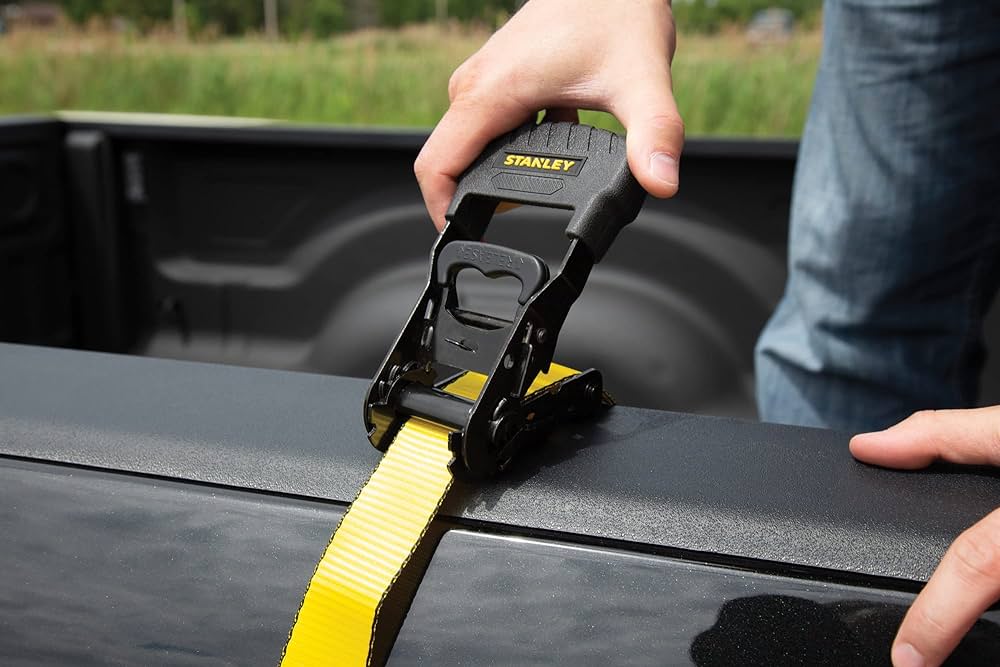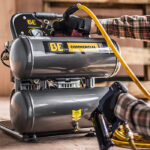Definition and Components of a Ratchet Strap
A ratchet strap, also known as a tie-down or cargo strap, is a versatile and essential tool used for securing loads during transportation or storage. It consists of two main components: a durable strap made of robust materials like polyester or nylon webbing, and a ratchet mechanism that allows for easy tightening and loosening.
The strap itself is typically flat and wide, designed to distribute the load evenly and prevent damage to the cargo or surface it’s secured to. The length of the strap can vary, with common sizes ranging from a few feet to several yards, depending on the intended application.
The ratchet mechanism is the heart of the system, providing the ability to incrementally tighten the strap and create a secure, snug fit around the load. This mechanism typically consists of a ratchet handle, a spool or drum, and a pawl or locking mechanism that prevents the strap from loosening unintentionally. By repeatedly cranking the ratchet handle, the strap is slowly drawn through the mechanism, tightening around the load until the desired tension is achieved.
Table of Contents
Ratchet Strap Components and Capacity
Ratchet straps are essential tools for securing loads during transportation. They consist of several key components that work together to provide reliable and adjustable tie-down solutions. Understanding these components is crucial for proper usage and safety.
Cam Buckle: The cam buckle is the heart of the ratchet strap system. It features a rotating gear mechanism that allows the strap to be tightened or released with ease. The cam buckle enables precise tensioning and ensures a secure grip on the strap, preventing it from loosening during transit.
Lever Buckle: The lever buckle is an alternative to the cam buckle and is often found on heavy-duty ratchet straps. It uses a lever-operated mechanism to grip and tighten the strap, providing a higher clamping force compared to cam buckles. Lever buckles are typically used for securing heavier loads or in situations where extra tightening power is required.
Flat Hooks: Flat hooks are commonly found at the end of ratchet straps and are designed to fit into tie-down points or anchor points on vehicles or trailers. These hooks are flat and wide, allowing for easy insertion and removal while providing a secure attachment point for the strap.
Wire Hooks: Wire hooks are an alternative to flat hooks and are often used in conjunction with ratchet straps. They are made of sturdy wire material and feature a curved shape that can easily hook onto various anchor points. Wire hooks are versatile and can be used in situations where flat hooks may not fit or provide sufficient grip.
Capacity Ratings: Ratchet straps are available in different capacity ratings, which indicate the maximum load they can safely secure. These ratings are typically expressed in pounds or kilograms and are determined by the strap’s material, width, and construction. It is crucial to choose the appropriate capacity rating based on the weight of the load being secured to ensure safe and reliable tie-down.
By understanding the components and capacity ratings of ratchet straps, users can select the right strap for their needs and properly secure loads, minimizing the risk of shifting or damage during transportation.
What Are Ratchet Straps Made Of?
Ratchet straps are typically made from durable synthetic materials like nylon, polyester, or polypropylene. These materials offer high tensile strength, resistance to abrasion, and resilience against harsh environmental conditions.
Nylon is a popular choice for ratchet straps due to its exceptional strength-to-weight ratio and resistance to moisture, chemicals, and ultraviolet radiation. Polyester ratchet straps are also highly durable and offer good resistance to stretching and abrasion.
Polypropylene is a lightweight and inexpensive option for ratchet straps, although it may not be as strong as nylon or polyester. However, polypropylene is resistant to many chemicals and has good heat resistance.
In some cases, steel ratchet straps are used for heavy-duty applications that require even greater strength and load-bearing capacity. Steel straps are highly resistant to cutting, abrasion, and stretching, but they are also heavier and more susceptible to corrosion than synthetic materials.
Causes of a Broken Ratchet Strap
Overloading
One of the primary reasons for a ratchet strap breaking is overloading. Ratchet straps are designed to withstand a specific amount of tension and weight, and exceeding this limit can cause the strap to snap or the ratchet mechanism to fail. Overloading can occur when securing excessively heavy loads or when the load shifts during transportation, putting excessive strain on the strap.
Wear and Tear
Like any other piece of equipment, ratchet straps are subject to wear and tear over time. Repeated use, exposure to harsh weather conditions, and improper storage can cause the strap material to weaken, leading to fraying or breakage. Additionally, the ratchet mechanism itself can become worn or damaged, making it less effective at maintaining tension.
Improper Use
Using a ratchet strap incorrectly can also contribute to its premature failure. For example, failing to properly secure the strap around the load or using it in a way it was not intended can put unnecessary stress on the strap and its components. Additionally, using a strap that is not rated for the intended load can lead to breakage.
Defective Manufacturing
In some cases, a broken ratchet strap may be the result of a manufacturing defect. This could include issues with the strap material, the ratchet mechanism, or the assembly process. While reputable manufacturers have quality control measures in place, defects can still occur, leading to premature failure of the strap.
Visual Inspection and Testing
When dealing with a potentially broken ratchet strap, the first step should always be a thorough visual inspection. Carefully examine the entire length of the strap, looking for any signs of wear, fraying, cuts, or other damage that could compromise its integrity. Pay close attention to areas where the strap bends or comes into contact with sharp edges, as these are common points of failure.
In addition to the strap itself, inspect the ratchet mechanism for any signs of damage or excessive wear. Ensure that the locking mechanism engages properly and that the ratchet teeth are not excessively worn or damaged. If any components appear to be compromised, it’s best to err on the side of caution and replace the entire strap.
After the visual inspection, it’s recommended to perform a load test in a controlled environment. Consult the manufacturer’s guidelines for the recommended testing procedures and maximum load capacities. During the load test, closely monitor the strap and ratchet for any signs of slippage, stretching, or failure. If the strap fails to meet the manufacturer’s specifications, it should be immediately taken out of service and replaced.
Proper Loading and Securing
Proper loading and securing of cargo is crucial when using ratchet straps. Overloading or improper load distribution can lead to strap failure, potentially causing damage to the cargo or posing safety hazards. Here are some key points to consider:
- Distribute the load evenly across the surface, avoiding excessive weight concentration in one area.
- Secure the load tightly, eliminating any potential for shifting during transport.
- Use the appropriate number of ratchet straps based on the size and weight of the load.
- Crisscross straps diagonally for added stability and tension distribution.
- Ensure the ratchet mechanism is functioning correctly and can maintain tension.
- Regularly inspect the straps for signs of wear, fraying, or damage before use.
By following proper loading and securing techniques, you can maximize the effectiveness of ratchet straps and prevent potential failures or accidents.
Personal Protective Equipment
When working with ratchet straps, it’s essential to wear appropriate personal protective equipment (PPE) to minimize the risk of injuries. Here are some recommended PPE items:
- Gloves: Wear sturdy gloves to protect your hands from abrasions, cuts, and pinch points when handling and tensioning the straps.
- Safety glasses or goggles: Protect your eyes from potential debris or strap recoil in case of failure.
- Steel-toed boots: Wear sturdy, steel-toed boots to safeguard your feet in case heavy objects or loads shift or fall.
- High-visibility clothing: Wear bright, reflective clothing to increase visibility, especially in low-light conditions or when working around moving vehicles.
Proper PPE not only protects you from potential hazards but also helps ensure your safety and well-being while working with ratchet straps.
Replacement Options for a Broken Ratchet Strap
When dealing with a broken ratchet strap, you have a few options to consider:
DIY Repairs
For minor damage or small cracks, you may be able to repair the strap yourself using a heavy-duty adhesive or epoxy. This can be a cost-effective solution, but it may not be as reliable or long-lasting as a full replacement.
Replacement Parts
If the damage is more significant or the strap is worn out, you can purchase a replacement ratchet strap from various retailers or directly from the manufacturer. This option ensures you have a new, high-quality strap that meets safety standards and can withstand heavy loads.
Professional Repair Services
In some cases, it may be more practical or necessary to have a professional repair service handle the replacement. This is especially true for specialized equipment or situations where safety is a critical concern. Professional repair services have the expertise, tools, and resources to ensure the job is done correctly and to the highest standards.
No matter which option you choose, it’s essential to address a broken ratchet strap promptly. These straps are crucial for securing loads during transportation or storage, and a faulty strap can lead to accidents, damage, or injuries.
Proper Use, Storage, and Maintenance of Ratchet Straps
Ratchet straps are essential tools for securing loads during transportation, but they require proper use, storage, and maintenance to ensure safety and longevity. Here are some essential tips:
Proper Use:
- Always follow the manufacturer’s instructions and load capacity ratings.
- Inspect the strap for any signs of wear, fraying, or damage before use.
- Ensure the ratchet mechanism is functioning correctly and not jammed or stuck.
- Secure the load evenly, avoiding sharp edges or corners that could damage the strap.
- Never stand in the potential rebound path when tightening the strap.
Storage:
- Store ratchet straps in a cool, dry place, away from direct sunlight and moisture.
- Coil the straps loosely to prevent creasing or kinking.
- Avoid storing ratchet straps near chemicals, solvents, or corrosive materials.
Maintenance:
- Regularly inspect the straps for any signs of wear, cuts, fraying, or damage.
- Replace straps that show excessive wear or have been subjected to a shock load.
- Lubricate the ratchet mechanism periodically with a light oil or lubricant.
- Clean the straps with mild soap and water, avoiding harsh chemicals or solvents.
Regular inspections and proper care can significantly extend the lifespan of your ratchet straps, ensuring they remain safe and reliable for securing your loads.
Safety Ratings and Testing Requirements for Broken Ratchet Straps
Ratchet straps are essential tools for securing loads during transportation, but a broken strap can pose serious safety risks. To ensure the safe handling and use of ratchet straps, various industry organizations have established guidelines and testing requirements to evaluate their performance and durability.
The Web Sling and Tie Down Association (WSTDA) is a leading authority that sets standards for the design, testing, and use of cargo securement devices, including ratchet straps. Their guidelines specify the minimum breaking strength requirements for different strap configurations, materials, and working load limits (WLL).
In addition to the WSTDA standards, ratchet straps must comply with regulations set by organizations like the Department of Transportation (DOT) and the Occupational Safety and Health Administration (OSHA). These regulations cover aspects such as load securement, worker safety, and the proper use of tie-down equipment.
Manufacturers of ratchet straps are required to conduct rigorous testing to ensure their products meet or exceed the established safety standards. These tests typically involve subjecting the straps to various conditions, such as tensile strength tests, abrasion resistance tests, and environmental exposure tests (e.g., extreme temperatures, UV radiation).
Furthermore, ratchet straps are assigned safety ratings based on their performance in these tests. These ratings indicate the maximum working load limit (WLL) and the minimum breaking strength of the strap. It is crucial to select the appropriate strap rating for the intended load and to inspect the strap for any signs of damage or wear before use.
By adhering to industry guidelines, safety ratings, and testing requirements, users can ensure that broken ratchet straps are identified and replaced, minimizing the risk of accidents and ensuring the safe transportation of cargo.
Load Capacity
A ratchet strap’s load capacity is one of its most critical specifications. This rating indicates the maximum weight or force the strap can safely withstand before risking failure or damage. Load capacities are typically measured in pounds or kilograms and vary based on the strap’s width, material composition, and overall construction quality.
Choosing a ratchet strap with an appropriate load capacity is essential for secure and safe load securement. Underestimating the required capacity can lead to catastrophic strap failure, potentially causing property damage, injuries, or accidents. Conversely, using an unnecessarily oversized strap can be cumbersome, expensive, and challenging to manage.
Most ratchet straps are rated for working load limits (WLL) and breaking strengths. The WLL represents the maximum weight the strap can safely hold under normal operating conditions, while the breaking strength is the force required to cause complete strap failure. As a general rule, it’s advisable to select a strap with a WLL that exceeds the intended load weight by a generous safety margin, typically 25-50%.



